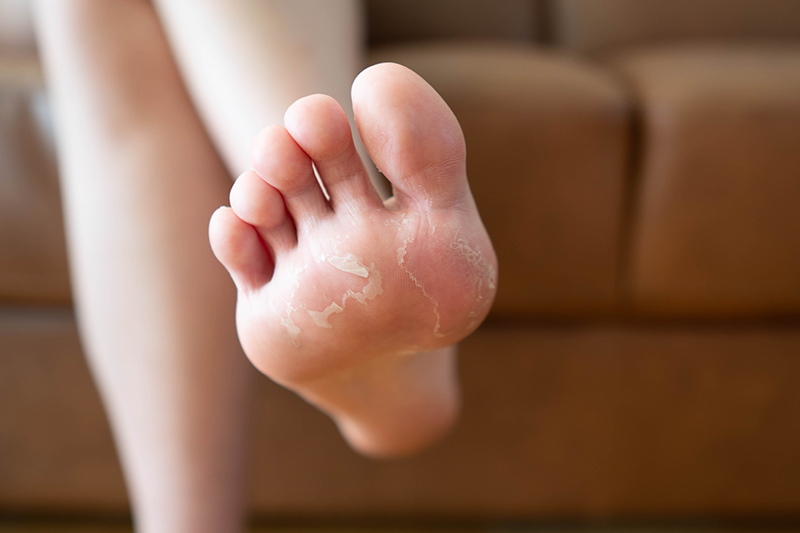Treatment of foot fungus
Treatment of foot fungus
Book Now
Treatment of foot fungus
Treatment of foot fungus
Fungal infections on the skin are a common issue that can negatively affect both the health and appearance of individuals, often leading to a decrease in confidence. Fungi are organisms that cannot photosynthesize like plants, so they rely on parasitic growth on a host, such as human skin, to survive and multiply under favorable conditions. Fungi are classified into single-celled and multicellular types, with the single-celled variety responsible for causing infections in humans.
One of the most common fungal infections is Tinea Pedis, or athlete’s foot, which primarily affects the feet. Although anyone at any age can contract this infection, it is particularly common among athletes, hence the name. This is because athletes often wear closed shoes for extended periods, creating the perfect conditions for sweating and fungal growth.
What is Athlete’s Foot?
Athlete's foot is a fungal infection that usually occurs between the toes and causes itching, burning, peeling, and redness of the skin. The infection can spread to other areas of the body, and because it is highly contagious, it can be transmitted through direct contact with an infected person or contaminated surfaces. For this reason, early diagnosis and treatment of athlete’s foot are crucial.
Symptoms of Athlete’s Foot
Athlete’s foot manifests through several common symptoms, including:
- Peeling or cracking skin between the toes
- Intense itching and burning sensations in the affected areas
- Small blisters and painful sores on the feet
- Redness and inflammation of the affected skin
- Foul odor emanating from the feet
Causes of Athlete’s Foot
The primary cause of athlete’s foot is excessive sweating and the prolonged confinement of feet in tight, closed shoes, which create a warm, moist environment ideal for fungal growth. Other contributing factors that can increase the risk of athlete’s foot include:
- Wearing ill-fitting shoes or shoes that do not allow proper ventilation
- Poor foot hygiene, such as not washing or thoroughly drying the feet after bathing
- Sharing personal items like socks and shoes with others
- Walking barefoot in public places like swimming pools, gyms, and locker rooms
- Having cuts or cracks in the skin, which allow fungi to enter and infect the skin
Diagnosis and Treatment
Doctors can usually diagnose athlete’s foot by examining the skin and recognizing the characteristic signs of the infection. In more advanced cases, a potassium hydroxide (KOH) test may be performed to confirm the presence of fungal elements.
Treatment typically involves the use of antifungal medications, which may be applied topically or taken orally, depending on the severity of the infection. These medications help eliminate the fungus and reduce symptoms such as itching and inflammation. In addition to medical treatment, it is important to keep the feet clean and dry, avoid wearing tight shoes, and replace wet socks regularly to prevent further fungal growth.
Prevention of Athlete’s Foot
Preventing athlete’s foot requires simple hygiene and care measures:
- Thoroughly dry your feet after washing, especially between the toes, where moisture tends to linger
- Opt for breathable shoes that allow airflow and reduce sweating
- Avoid walking barefoot in public spaces such as swimming pools, gym showers, and locker rooms
- Refrain from sharing personal items such as socks, shoes, and towels with others
- If your feet sweat excessively, use antifungal foot powder or wear moisture-wicking socks to help keep your feet dry
Who is at Higher Risk?
Certain groups of people are more prone to contracting athlete’s foot, including athletes, soldiers, and individuals who work in warm and humid environments. These groups often keep their feet enclosed in shoes for long periods, which increases the likelihood of fungal growth. Additionally, elderly people and those with weakened immune systems—such as patients with diabetes, cancer, or HIV—are at higher risk for fungal infections due to their reduced ability to fight off infections.
Conclusion
Athlete’s foot is a widespread and contagious fungal infection that requires prompt attention and care. Maintaining good foot hygiene, keeping the feet dry, and seeking appropriate treatment can help prevent the spread of the infection and alleviate its symptoms. By following these preventive measures and adopting proper footwear habits, you can significantly reduce your risk of developing athlete’s foot.
Make an Appointment
The best way to enjoy a treatment at our salon is to book an appointment with the desired esthetician. Fill in the form below and we will contact you to discuss your appointment.